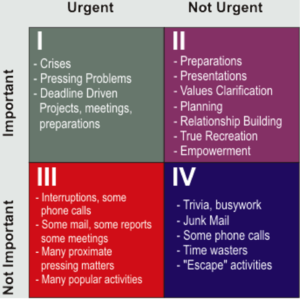How Leaders Set Priorities
“What is important is seldom urgent and what is urgent is seldom important.”
President Eisenhower
A top leader should favor important but not urgent issues. This refers to the idea that a top leader should spend as much as 80% of his time this way. If he is spending a high percentage of the time on ''urgent and important issues, or worse on urgent but not important stuff, his priority system probably has some deep flaws or he has not delegated well. Time spent on not urgent and not important issues is just a rest period.
History
President Eisenhower defined what has become known as the "Eisenhower decision principle." Stephen Covey popularized the Eisenhower’s decision principle in his book, The 7 Habits of Highly Effective People. Covey created a decision matrix to help individuals make the distinction between what’s important and not important and what’s urgent and not urgent. The matrix consists of a square divided into four boxes, or quadrants, labeled:
- Urgent/Important,
- Not Urgent/Important,
- Urgent/Not Important, and
- Not Urgent/Not Important.
Author
The author of this page is John Macpherson
John Macpherson is currently Chairman of the Board of the Anvil Corporation. Anvil is a 100% ESOP-owned corporation providing full-service engineering, design, procurement, and project management services in the U.S. and Canada.
John joined Anvil in 1971 and served as Anvil's President from 2003-2009. He has extensive experience in business management, engineering management, project management, and design engineering, primarily for the petroleum refining industry. John led Anvil's efforts to apply computer technologies to all aspects of engineering, project management, and resource management.
John holds a B.S. in Mechanical Engineering from the University of California at Davis. He also attended the Program for Management Development at the Harvard Business School. He holds Professional Mechanical Engineer licenses in the States of Washington and Alaska.
